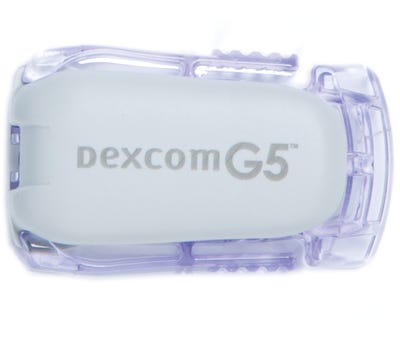December 21, 2016
FDA approval of Dexcom's dosing claim is seen as a major stride in the journey to eliminate finger pricks for good in diabetes management.
Amanda Pedersen

Dexcom's G5 is the first FDA-approved continuous glucose monitoring device to win dosing claim, allowing patients to rely on the CGM readings for daily treatment decisions, with fewer fingerpricks
A new FDA label approval this week represented a big step for Dexcom Inc., and an even bigger step for the diabetes management community at large.
The agency decided to expand the indication for the San Diego-based company's G5 mobile continuous glucose monitoring (CGM) system, allowing patients to use the device to guide daily treatment decisions, such as insulin dosing, without pricking their finger first to to test their blood sugar.
The label expansion was expected, based on a favorable advisory panel hearing in July, but it did come a bit early. Dexcom previously told investors that an early 2017 FDA decision was likely.
For people like Steven Edelman, founder and director of a nonprofit patient advocacy organization called Taking Control of Your Diabetes, the approval means being able to go up to 12 hours without a finger prick, and having the freedom to go about their day without carrying a glucose meter everywhere. Edelman called the news "truly momentous" for people living with the disease.
"It completely changes the way that we manage our diabetes and gives us chance to gain much better control of the disease without all of the pain and hassle of constant finger sticks," Edelman said.
Patients will still have to lance their finger to calibrate their CGM device, but the dosing claim could be a major step along the journey to a completely fingerstick-free solution.
From a market share perspective, FDA's decision puts Dexcom even farther ahead of its competition than it already was, according to Douglas Schenkel, a Cowen and Company analyst. He said the approval should drive incremental patient and physician awareness and adoption, and allow Dexcom to pursue Medicare coverage, which represents about 10% to 20% of the type I diabetes population. Under the previous label restrictions, CMS viewed CGM as an added cost to the system because it could only be used in along with - not instead of - fingersticks, Schenkel said. That coverage decision, he added, could be made at some point in 2018.
But the decision could also play a significant role in persuading more doctors and patients to give CGM a shot. As Qmed's sister publication, MD+DI, reported in April, a lot of doctors have refrained from recommending the technology due to the burdensome on-label requirements of the product under its original approval.
"If Dexcom's G5 performance is the bar, the two biggest competitors (Medtronic and Abbott) appear unlikely to receive this label claim for at least two years, if not longer," Schenkel said. That also means Dexcom could be the only CGM player with Medicare coverage for some time, he said.
Some questions raised during the July advisory panel hearing still linger, the analyst said, such as what the training requirements will be for the new indication, what Dexcom's post-market study requirements will be, and how FDA will treat competing adjunctive CGM devices subsequent to this approval.
Amanda Pedersen is Qmed's news editor. Reach her at [email protected].
[Image credit: Dexcom Inc.]
About the Author(s)
You May Also Like


